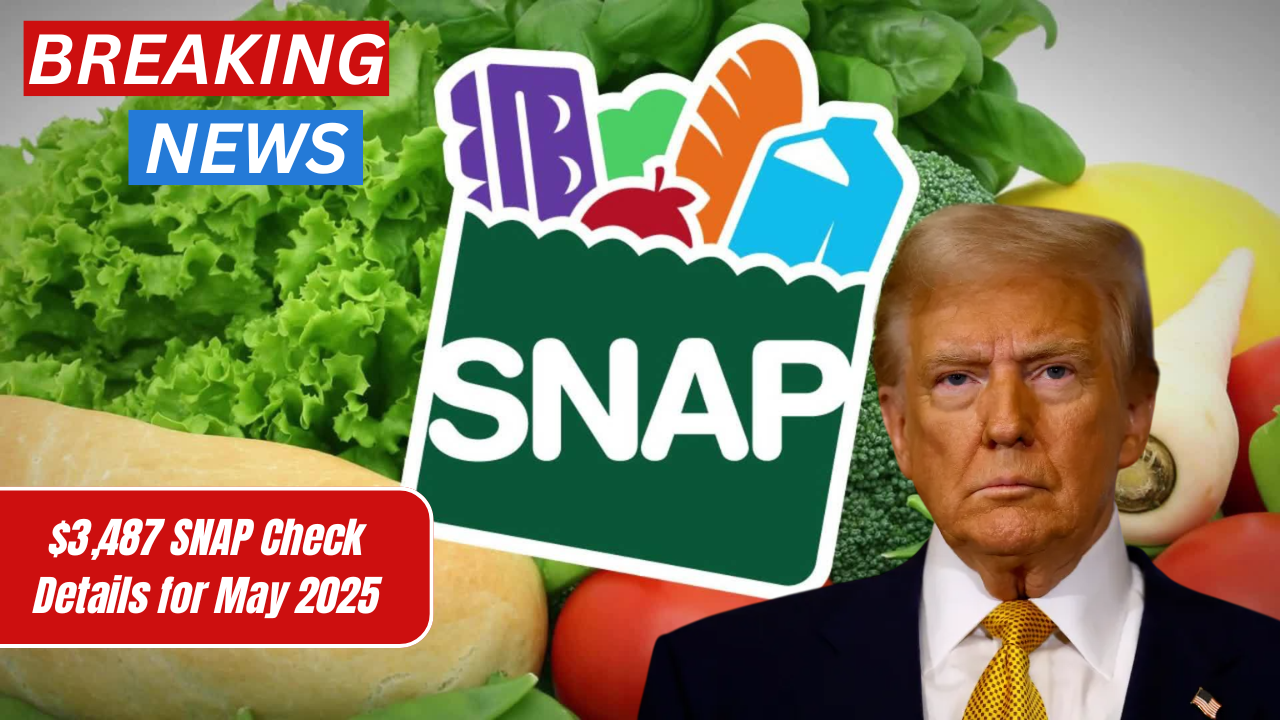The Supplemental Nutrition Assistance Program (SNAP) is a crucial lifeline for millions of Americans, offering financial assistance to purchase food and improve the quality of life for those facing financial hardship. In May 2025, recipients of SNAP will see an increase in the amount they receive, with the new check amounting to $3,487. This increase aims to address the rising cost of living, inflation, and food prices, providing vital support to families and individuals in need.
In this comprehensive guide, we will break down the details of the $3,487 SNAP check for May 2025, eligibility requirements, application processes, state-specific variations, and ways to maximize SNAP benefits. Additionally, we’ll explore the impact of SNAP on households and communities, offering a deeper understanding of this essential program.
1. Introduction to SNAP
What is SNAP?
The Supplemental Nutrition Assistance Program (SNAP) is a federal program administered by the U.S. Department of Agriculture (USDA) that helps low-income individuals and families purchase nutritious food. SNAP is designed to improve food security, reduce poverty, and enhance public health. Benefits are distributed monthly on an Electronic Benefits Transfer (EBT) card, which can be used at authorized food retailers.
The History of SNAP
SNAP, initially known as the Food Stamp Program, was established in the 1960s as part of President Lyndon B. Johnson’s War on Poverty. It has since undergone various updates and changes to adapt to shifting economic conditions and the needs of a growing population. In 2008, the program was renamed SNAP, reflecting its modernized benefits system, which moved away from physical food stamps to digital EBT cards.
How SNAP Works
Eligibility for SNAP is based on household size, income, expenses, and other factors. Applicants must meet specific income guidelines, and benefits are calculated based on these factors. The amount of assistance provided is meant to bridge the gap between a household’s income and the cost of purchasing nutritious food.
2. Understanding the May 2025 $3,487 SNAP Check
Breakdown of the $3,487 SNAP Check
In May 2025, eligible households may receive a SNAP check totaling $3,487. This amount is based on several factors, including the number of people in the household, their combined income, housing costs, and other eligible expenses. The $3,487 represents a significant increase from previous years, reflecting both inflation and changes in government policy.
Factors Affecting SNAP Benefit Amounts
The SNAP benefit amount for a household is determined by:
- Household Size: Larger households generally receive higher benefits to accommodate the increased need for food.
- Income Levels: Households with lower income levels will qualify for higher SNAP benefits. Income from employment, social security, child support, and other sources is factored in.
- Housing and Utility Costs: Expenses for rent, mortgage, utilities, and other necessary living costs are considered when calculating SNAP benefits.
- Other Deductions: Households may also be eligible for deductions based on childcare costs, medical expenses, and other unique circumstances.
Who Qualifies for the May 2025 SNAP Increase?
To qualify for SNAP in May 2025, individuals and families must meet the following basic requirements:
- Income Limits: Applicants must have a gross monthly income below a certain threshold, which varies based on the number of people in the household.
- U.S. Citizenship or Legal Status: SNAP benefits are only available to U.S. citizens or legal immigrants.
- Residency: Applicants must reside in the state where they apply for benefits.
- Work Requirements: Adults without dependents must work or participate in work training programs to qualify for SNAP.

While SNAP is a federal program, each state administers its own program, and benefits can vary from state to state. Factors such as the local cost of living, housing expenses, and state-specific economic conditions play a significant role in determining the amount of SNAP benefits.
Differences in SNAP Benefits by State
Some states, such as California, New York, and Hawaii, have a higher cost of living, and thus offer higher SNAP benefits to recipients. In contrast, states like Mississippi, Arkansas, and West Virginia, which have a lower cost of living, may offer lower SNAP benefits.
Examples of States with Higher or Lower Benefit Amounts
- California: Given its high housing and living costs, California residents may receive a maximum SNAP benefit of $3,500 or more for a household of four.
- Mississippi: In contrast, a household in Mississippi may receive around $2,800 for the same size household.
4. How to Apply for SNAP in 2025
Eligibility Requirements
Before applying for SNAP, you must check if you meet the eligibility requirements based on your household size, income, and expenses. You can visit your state’s SNAP website to find out more about the specific requirements for your state.
Documents Needed for the Application
When applying for SNAP, you will need to provide:
- Proof of identity (birth certificate, driver’s license, etc.)
- Proof of income (pay stubs, bank statements, etc.)
- Proof of household expenses (rent receipts, utility bills, etc.)
- Social security numbers for all household members
Application Process (Online and In-Person)
Applications for SNAP can be made online through your state’s SNAP portal, or you can apply in person at a local SNAP office. Most states also have mobile apps that allow you to submit your application electronically.

5. Recent Changes to SNAP (2025)
Policy Changes in SNAP
In 2025, there have been a number of policy changes that affect the SNAP program:
- Increased Funding: The federal government has allocated additional funds to SNAP to accommodate for inflation and rising food costs.
- Expanded Eligibility: More households will qualify for SNAP benefits due to changes in income guidelines.
- Improved Access: The application process has been streamlined with better access to online services, making it easier for people to apply.
The Impact of Inflation and Economic Factors on SNAP
Inflation has been a significant factor in the increased SNAP benefit for May 2025. Rising food prices and living costs have placed a strain on low-income households, and SNAP benefits have been adjusted to reflect these changes.
6. How to Maximize Your SNAP Benefits
Tips for Efficient Use of SNAP Benefits
- Shop in Bulk: Purchase non-perishable items in bulk to save money.
- Use Coupons: Many stores accept coupons along with SNAP benefits, allowing you to save even more.
- Prioritize Nutrient-Dense Foods: Focus on buying fresh fruits, vegetables, and whole grains to maximize the health benefits of your SNAP check.
Meal Planning with SNAP
Meal planning is a great way to stretch your SNAP benefits. By planning your meals ahead of time, you can purchase ingredients in bulk, avoid food waste, and ensure that your family is eating nutritious meals.
Combining SNAP with Other Assistance Programs
If you’re eligible, consider combining SNAP benefits with other assistance programs such as the Women, Infants, and Children (WIC) program, food banks, and other local initiatives to stretch your resources even further.
7. The Impact of SNAP on Families and Communities
SNAP’s Role in Reducing Hunger and Poverty
SNAP is one of the most effective tools in reducing food insecurity and alleviating poverty in the United States. By providing low-income households with the means to purchase food, SNAP helps ensure that families can access the nutrition they need to thrive.
Long-Term Benefits of SNAP
Beyond immediate food assistance, SNAP has long-term benefits. Studies have shown that children in households receiving SNAP benefits are less likely to experience long-term health issues related to nutrition, including obesity and diabetes.
8. Conclusion
The $3,487 SNAP check for May 2025 represents a significant increase in federal support for those in need. With rising food costs and living expenses, this increase is a timely response to the economic challenges faced by many households. By understanding how SNAP works, eligibility requirements, and how to apply, recipients can better navigate the application process and maximize their benefits.
Table: SNAP Benefits Breakdown for Different Household Sizes
| Household Size | Monthly Income | SNAP Benefit Amount (May 2025) |
|---|---|---|
| 1 Person | $1,500 | $1,200 |
| 2 Persons | $2,000 | $2,000 |
| 4 Persons | $3,000 | $3,487 |
| 6 Persons | $3,500 | $3,487 |
9. FAQs
1. What is SNAP?
SNAP (Supplemental Nutrition Assistance Program) is a federal program that helps low-income individuals and families purchase food.
2. How do I apply for the $3,487 SNAP check?
You can apply for SNAP online through your state’s portal or in person at a local office.
3. What determines the amount of the SNAP check?
The amount of the SNAP check is determined by household size, income, and other expenses like housing and utilities.
4. Can SNAP benefits be used for anything other than food?
No, SNAP benefits can only be used for purchasing food, not for household items or non-food products.
5. How often do SNAP benefits change?
SNAP benefits are adjusted annually, reflecting changes in inflation and economic conditions.

